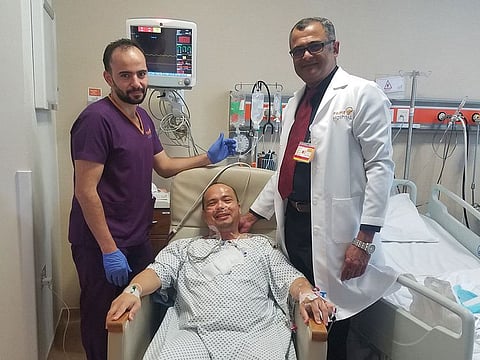Feeling exhausted? Check for Conn's disease
Feeling weak? Have high blood pressure, low potassium levels? Get checked out for this

When UAE resident Jonathan first felt exhausted, he put it down to a hard day’s work. But when this tiredness persisted and he developed high blood pressure and low potassium levels and began to feel weak, he became concerned. Doctors at first were unable to pin-point the problem, but eventually diagnosed him with Conn’s disease. In this syndrome a benign tumor develops on an adrenal gland. It is responsible for 3 per cent of cases of hypertension worldwide.
In Johnathan’s case, the tumour was secreting excess aldosterone, which resulted in high blood pressure, low blood potassium levels and elevated aldosterone levels – responsible for fluid and electrolyte stability - in his blood.
Dr Sanjay Bhat, Specialist Urologist at Prime Hospital, used keyhole surgery to remove the gland that had a tumour attached. Two days after his operation, Jonathan was home.
Now, two weeks have gone by and he can’t contain his grin. He feels energetic and his blood pressure is under control.
Both doctor and patient warn of the same thing – not being vigilant about your health.
We asked Dr Bhat to explain the signs and symptoms of Conn’s disease – here’s how it could be affecting you.
Symptoms:
It's a triad of issues: Hypertension (high blood pressure) along with Hypokalemia ( low blood potassium levels) and Hyperplasia (increased number of cells) or adenoma(benign tumor) in one or both adrenal glands.
What is an adrenal gland?
There are two tiny endocrine glands adjacent to each kidney called adrenal gland. These small glands secrete important hormones like steroids; catecholamines, like adrenaline, important for “flight and fight” responses; fludrocortisone; and Aldosterone - for fluid and electrolyte stability which are needed to maintain levels of potassium, sodium and water in the body.
What happens when you get an adrenal gland tumour?
Small tumours of these glands can cause devastation if any of the above hormones are secreted at increased levels by these tumours. When produced in excess it causes hypertension that is difficult to control and low potassium levels that is difficult to correct and causes extreme muscle weakness to the level that the muscles feel paralysed sometimes.
If the doctor suspects Conn’s, what’s the next step?
1. Ultrasound scan
2. Check blood levels of Aldosterone. If this is high, a CT scan should be ordered even if the ultrasound is normal. These tumors are generally less than 3 centimetres in length and can be missed on ultrasound.
Is surgery the only option?
Patients unfit or unwilling for surgery can be placed on medications called aldactone and potassium supplements, but this may not do the trick. Lifestyle modification may also help along with this.
Surgery through a keyhole has dramatic benefits with all the benefits of minimal access surgery like recovery, pain and cosmesis.
Sign up for the Daily Briefing
Get the latest news and updates straight to your inbox



